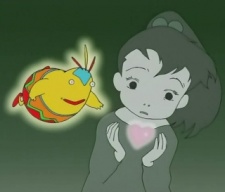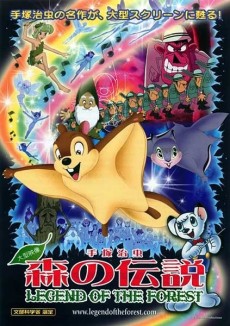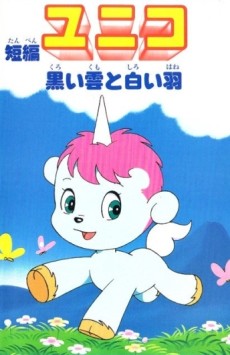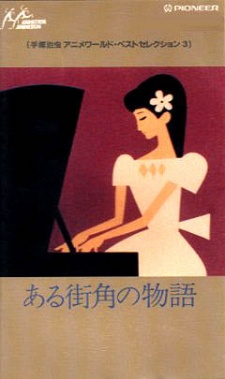JUMPING
MOVIE
Dubbed
SOURCE
ORIGINAL
RELEASE
June 16, 1984
LENGTH
6 min
DESCRIPTION
A boy walks down the street and as he goes along his strides increase. Eventually he leaps over towns, forests, and oceans, seeing many things and surprising many people along the way.
(Source: Anime News Network)
REVIEWS

TeKSMeLater
80/100Six minutes of experimental Tezuka goodness.Continue on AniListEven at the twilight of his life and career, the legendary mangaka Osamu Tezuka continued to busy himself with several circulating manga publications, as well as dabbling in animation as a hobby. In fact, there have been accounts of him going out of his way to fund projects with money from his own pocket. One of those instances is with Jumping, Tezuka’s entry for the 1984 Animafest Zagreb, a prestigious animated film festival organized by the International Animated Film Association or ASIFA.
Back in 1981, Tezuka enlisted the help of animator Junji Kobayashi, who famously worked on the ambitious animated cityscape scene in Hi no Tori 2772, also a film by Tezuka. Jumping is envisioned to be a grand expansion of that scene—a continuous, fluid short of a child who jumps, and jumps, and jumps until he reaches clouds, skyscrapers, forests, and normally unreachable areas, while subtly infusing outlooks on society represented by quick shots of the environments he jumps to. With limited technology, Kobayashi had to think out of the box to be able to acquire reference shots for the short. Unlike Hi no Tori 2772 where he and the animation staff were able to create a model of the futuristic city within the Tezuka Pro office hallway, the sheer scale of Tezuka’s storyboard had led to him hopping on similar roads to imitate the movement, as well as riding on a Cessna plane to take the aerial shots necessary. The result was a six-minute visual wonder consisting of approximately 4,000 cuts (!) made over the course of a two-and-a-half-year long production period.
While admittedly not consistently fluid (and at times possibly nauseating), the formidable scope within this short, as well as the fact that this work is produced without any reliance on CGI, is nothing short of inspiring. Within a short amount of time Tezuka crams in as much visual information as possible through each jump, not being overbearing on its gradual shift to disturbing imagery while imbuing in as much meaning as he can. Unsurprisingly, Tezuka would go on and win the Zagreb award, in fact being the first Japanese to ever do so, and the only one alongside Koji Yamamura to win it to this day.
Jumping is possibly one of Tezuka’s most nuanced and definitive works. Kobayashi, of course, also deserves recognition for undertaking in this monumental project. This film is one of the many testaments that display the man’s infectious passion for the medium that continues to be felt within the industry beyond his death.

Hopesfall
90/100Deft and boldly telltale, Tezuka's Jumping dwells on the sanctity of preservation at every available corner.Continue on AniListThis was recommended to me by a friend whom I had told not long before being instructed to wander this rabbit hole out of plaintive desire that I was only into animated shorts now and that I had long worn thin of the longform narrative in cartoons. I sensibly wanted a respite from the inconsolable might the average 12-24 episodes had on my fragile emotional state, and thus didn't want to have to deal with any potential long-term investment in established worlds and mundanities associated with "the continuity", so to speak. This friend of mine, you see, was a major Tezuka enthusiast. He would collect supply drop after supply drop of commemorative Osamu Tezuka memorabilia be it autobiographies or secondhand accounts of the man's working life through the late 20th century, and at the same time, urge others like myself who could muster an appetite for all things nerdy and secular in terms of interests to read Tezuka manga if only to glimpse the master at work through the lens of a reader living in modern times. Of course, I abstained for the longest time since I was not ready to hop aboard the "be all end all" express where the finality of art could be grasped by even the layman. NO, I WAS NOT READY TO FEAST MY EYES ON HIS BODY OF WORK JUST YET. I needed a bit more breathing space before I could.
And then it clicked in my head. What if I started not with his written oeuvre, but his directorial craft? That would be conducive for a first-timer like myself, would it not? Heh, talk about a dash of adept decision-making, that one. I decided to take my aforementioned friend up on his suggestion to check out this short after another I'd already seen beforehand, Broken Down Film, and what a buffet for the senses it was! The editing was supreme, and not to mention (likely) instrumental in the pioneeering and subsequent realization of Satoshi Kon's inimitable magic with the camera and how he plays around with the editing in his films. I'm sure many other industry creatives were inspired by Tezuka's work in the early phases of their careers.
And now on to the short itself, which i will keep concise and to the point. It is simply a masterstroke of technique. Secondary to the already prominent displays of gyroscopic camera movement which would immediately pass for peer review by academics at the time of its release, coupled with the unconventional angles the pov of both character and viewer introduce whilst mid-air and on the ground, the short's defining quality is how attention to detail is NEVER ESCHEWED, regardless of what you may opine quietly by yourself. Denial only results in misappreciation for this particular vision of Tezuka's, and how could one not stand in awe at the glory of those towering cityscapes beholden to a regressing society, not one that is privy to change and environmental preservation? All of it amounts to a perfectly illustrated premonition of a future yet to come and everything from its charm to its grievous fixations on death and dysfunction paints a forlorn picture of the human race's trajectory at the height of the global economic boom in the 80s. Do yourself and your kindred a favor by watching this short, but do so at your own discretion seeing as the takeaway may alienate some from what it ultimately dares to convey.
SIMILAR ANIMES YOU MAY LIKE
 OVA FantasyTobira wo Akete (1995)
OVA FantasyTobira wo Akete (1995) MOVIE AdventureMori no Densetsu
MOVIE AdventureMori no Densetsu MOVIE AdventureUnico: Kuroi Kumo Shiroi Hane
MOVIE AdventureUnico: Kuroi Kumo Shiroi Hane
SCORE
- (3.05/5)
MORE INFO
Ended inJune 16, 1984
Favorited by 14 Users


